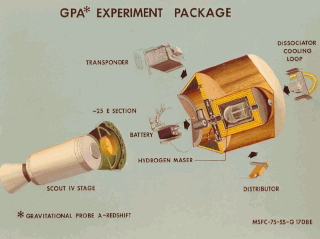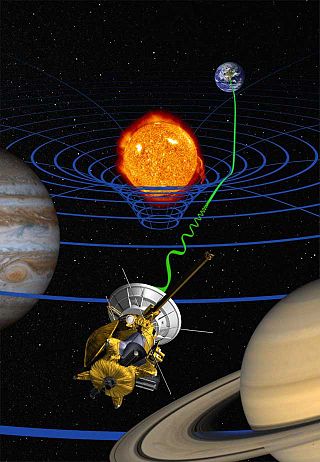
General relativity, also known as the general theory of relativity and Einstein's theory of gravity, is the geometric theory of gravitation published by Albert Einstein in 1915 and is the current description of gravitation in modern physics. General relativity generalises special relativity and refines Newton's law of universal gravitation, providing a unified description of gravity as a geometric property of space and time or four-dimensional spacetime. In particular, the curvature of spacetime is directly related to the energy and momentum of whatever matter and radiation are present. The relation is specified by the Einstein field equations, a system of second order partial differential equations.
In classical physics and special relativity, an inertial frame of reference is a frame of reference not undergoing any acceleration. It is a frame in which an isolated physical object—an object with zero net force acting on it—is perceived to move with a constant velocity or, equivalently, it is a frame of reference in which Newton's first law of motion holds. All inertial frames are in a state of constant, rectilinear motion with respect to one another; in other words, an accelerometer moving with any of them would detect zero acceleration.

In physics, the special theory of relativity, or special relativity for short, is a scientific theory of the relationship between space and time. In Albert Einstein's 1905 treatment, the theory is presented as being based on just two postulates:
- The laws of physics are invariant (identical) in all inertial frames of reference.
- The speed of light in vacuum is the same for all observers, regardless of the motion of light source or observer.

In physics, spacetime is any mathematical model that fuses the three dimensions of space and the one dimension of time into a single four-dimensional continuum. Spacetime diagrams are useful in visualizing and understanding relativistic effects such as how different observers perceive where and when events occur.

The theory of relativity usually encompasses two interrelated physics theories by Albert Einstein: special relativity and general relativity, proposed and published in 1905 and 1915, respectively. Special relativity applies to all physical phenomena in the absence of gravity. General relativity explains the law of gravitation and its relation to the forces of nature. It applies to the cosmological and astrophysical realm, including astronomy.

In physics, gravity (from Latin gravitas 'weight') is a fundamental interaction which causes mutual attraction between all things that have mass. Gravity is, by far, the weakest of the four fundamental interactions, approximately 1038 times weaker than the strong interaction, 1036 times weaker than the electromagnetic force and 1029 times weaker than the weak interaction. As a result, it has no significant influence at the level of subatomic particles. However, gravity is the most significant interaction between objects at the macroscopic scale, and it determines the motion of planets, stars, galaxies, and even light.
In physics and astronomy, a frame of reference is an abstract coordinate system whose origin, orientation, and scale are specified by a set of reference points―geometric points whose position is identified both mathematically and physically.
In physics, the principle of relativity is the requirement that the equations describing the laws of physics have the same form in all admissible frames of reference.
In theoretical physics, particularly in discussions of gravitation theories, Mach's principle is the name given by Albert Einstein to an imprecise hypothesis often credited to the physicist and philosopher Ernst Mach. The hypothesis attempted to explain how rotating objects, such as gyroscopes and spinning celestial bodies, maintain a frame of reference.
Galilean invariance or Galilean relativity states that the laws of motion are the same in all inertial frames of reference. Galileo Galilei first described this principle in 1632 in his Dialogue Concerning the Two Chief World Systems using the example of a ship travelling at constant velocity, without rocking, on a smooth sea; any observer below the deck would not be able to tell whether the ship was moving or stationary.

Length contraction is the phenomenon that a moving object's length is measured to be shorter than its proper length, which is the length as measured in the object's own rest frame. It is also known as Lorentz contraction or Lorentz–FitzGerald contraction and is usually only noticeable at a substantial fraction of the speed of light. Length contraction is only in the direction in which the body is travelling. For standard objects, this effect is negligible at everyday speeds, and can be ignored for all regular purposes, only becoming significant as the object approaches the speed of light relative to the observer.

Gravity Probe A (GP-A) was a space-based experiment to test the equivalence principle, a feature of Einstein's theory of relativity. It was performed jointly by the Smithsonian Astrophysical Observatory and the National Aeronautics and Space Administration. The experiment sent a hydrogen maser—a highly accurate frequency standard—into space to measure with high precision the rate at which time passes in a weaker gravitational field. Masses cause distortions in spacetime, which leads to the effects of length contraction and time dilation, both predicted results of Albert Einstein's theory of general relativity. Because of the bending of spacetime, an observer on Earth should measure a slower rate at which time passes than an observer that is higher in altitude. This effect is known as gravitational time dilation.
In theoretical physics, general covariance, also known as diffeomorphism covariance or general invariance, consists of the invariance of the form of physical laws under arbitrary differentiable coordinate transformations. The essential idea is that coordinates do not exist a priori in nature, but are only artifices used in describing nature, and hence should play no role in the formulation of fundamental physical laws. While this concept is exhibited by general relativity, which describes the dynamics of spacetime, one should not expect it to hold in less fundamental theories. For matter fields taken to exist independently of the background, it is almost never the case that their equations of motion will take the same form in curved space that they do in flat space.
Gravitational time dilation is a form of time dilation, an actual difference of elapsed time between two events as measured by observers situated at varying distances from a gravitating mass. The lower the gravitational potential, the slower time passes, speeding up as the gravitational potential increases. Albert Einstein originally predicted this effect in his theory of relativity and it has since been confirmed by tests of general relativity.

In the theory of general relativity, the equivalence principle is the equivalence of gravitational and inertial mass, and Albert Einstein's observation that the gravitational "force" as experienced locally while standing on a massive body is the same as the pseudo-force experienced by an observer in a non-inertial (accelerated) frame of reference.

General relativity is a theory of gravitation developed by Albert Einstein between 1907 and 1915. The theory of general relativity says that the observed gravitational effect between masses results from their warping of spacetime.
In physics, Albert Einstein derived the theory of special relativity in 1905 from principle now called the postulates of special relativity. Einstein's formulation is said to only require two postulates, though his derivation implies a few more assumptions.
A non-inertial reference frame is a frame of reference that undergoes acceleration with respect to an inertial frame. An accelerometer at rest in a non-inertial frame will, in general, detect a non-zero acceleration. While the laws of motion are the same in all inertial frames, in non-inertial frames, they vary from frame to frame depending on the acceleration.
The mathematics of general relativity is complex. In Newton's theories of motion, an object's length and the rate at which time passes remain constant while the object accelerates, meaning that many problems in Newtonian mechanics may be solved by algebra alone. In relativity, however, an object's length and the rate at which time passes both change appreciably as the object's speed approaches the speed of light, meaning that more variables and more complicated mathematics are required to calculate the object's motion. As a result, relativity requires the use of concepts such as vectors, tensors, pseudotensors and curvilinear coordinates.
The paradox of a charge in a gravitational field is an apparent physical paradox in the context of general relativity. A charged particle at rest in a gravitational field, such as on the surface of the Earth, must be supported by a force to prevent it from falling. According to the equivalence principle, it should be indistinguishable from a particle in flat spacetime being accelerated by a force. Maxwell's equations say that an accelerated charge should radiate electromagnetic waves, yet such radiation is not observed for stationary particles in gravitational fields.







